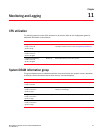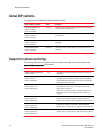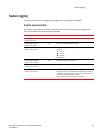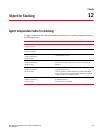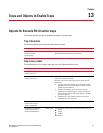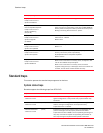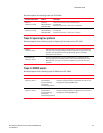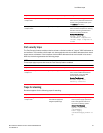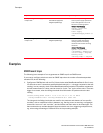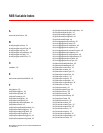
58 Brocade 6910 Ethernet Access Switch MIB Reference
53-1002582-01
Standard traps
Standard traps
This section present the standard traps supported on devices.
System status traps
Brocade supports the following traps from RFC 1215:
fdryTrapReceiverAddr
brcdIp.1.1.10.1.1.1.1.3
Syntax: InetAddress
Read-create The IP address of the SNMP manager that will receive the trap.
fdryTrapReceiver
CommunityOrSecurityName
brcdIp.1.1.10.1.1.1.1.4
Syntax: OctetString
(size(0..32))
Read-create The community string to use to access the trap receiver. This
object can have up to 32 octets. In the case of USM (SNMPv3)
security model, this object is used to provide the security name.
Writing a null string sets the name to “public”.
fdryTrapReceiverUDPPort
brcdIp.1.1.10.1.1.1.1.5
Syntax: Integer32
(0..65535)
Read-create The UPD port number of the trap receiver.
Valid value: 0 – 65535
Default: 162
fdryTrapReceiverSecurityModel
brcdIp.1.1.10.1.1.1.1.6
Syntax: SecurityModel
Read-create The version of trap format to be used.
Default: v1
fdryTrapReceiverSecurityLevel
brcdIp.1.1.10.1.1.1.1.7
Syntax: SecurityLevel
Read-create Used for USM (SNMPv3) security model to specify the level of
security. The security name is provided by
fdryTrapReceiverCommunityOrSecurityName.
Default: noAuth
fdryTrapReceiverRowStatus
brcdIp.1.1.10.1.1.1.1.8
Syntax: RowStatus
Read-create This variable is used to create, or delete a row in this table.
When a row in this table is in active(1) state, no objects in that
row can be modified except this object.
When a row in this table is in active(1) state, the switch
supports writing active(1) or destroy(6), the former of which has
no effect, and the latter of which deletes this entry.
Name, OID, and Syntax Access Description
Trap Name and Number Varbind Description
coldStart
1.3.6.1.6.3.1.1.5.1
(None) Indicates that the sending protocol entity is re-initializing itself: the
agent's configuration or the protocol entity implementation may
be altered.
warmStart
1.3.6.1.6.3.1.1.5.2
(None) Indicates that the sending protocol entity is re-initializing itself;
however, the agent configuration nor the protocol entity
implementation is not altered.
authenticationFailure
1.3.6.1.6.3.1.1.5.5
(None) Indicates that the sending protocol entity is the addressee of a
protocol message that is not properly authenticated. While
implementations of the SNMP must be capable of generating this
trap, they must also be capable of suppressing the emission of
such traps through an implementation-specific mechanism.




